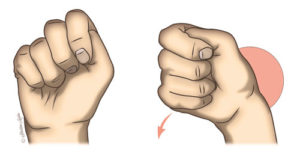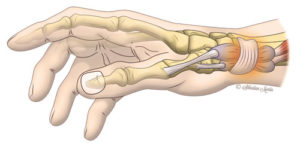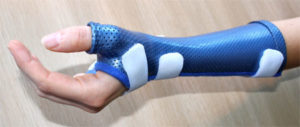Condition brought on by irritation or inflammation of the wrist tendons at the base of the thumb.
The inflammation causes the compartment (a tunnel or a sheath) around the tendon to swell and enlarge, making thumb and wrist movement painful. Making a fist, grasping or holding objects—often infants—are common painful movements with deQuervain’s tendonitis.
First dorsal compartment tendonitis, more commonly known as deQuervain’s tendonitis or tenosynovitis after the Swiss surgeon Fritz de Quervain.
What causes DeQuervain’s Tenosynovitis?
The cause of deQuervain’s tendonitis is an irritation of the tendons at the base of the thumb, usually caused by taking up a new, repetitive activity. New mothers are especially prone to this type of tendonitis: caring for an infant often creates awkward hand positioning, and hormonal fluctuations associated with pregnancy and nursing further contribute to its occurrence. A wrist fracture can also predispose a patient to deQuervain’s tendonitis, because of increased stresses across the tendons.
Signs and symptoms
Pain over the thumb-side of the wrist is the main symptom. The pain may appear either gradually or suddenly, and pain is located at the first dorsal compartment at the wrist. Pain may radiate down the thumb or up the forearm. Hand and thumb motion increases pain, especially with forceful grasping or twisting. Swelling over the base of the thumb may include a fluid-filled cyst in this region. There may be an occasional “catching” or “snapping” when moving the thumb. Because of the pain and swelling, motion such as pinching may be difficult. Irritation of the nerve lying on top of the tendon sheath may cause numbness on the back of the thumb and index finger.

Diagnosis
Tenderness directly over the tendons on the thumb-side of the wrist is the most common finding. A test is generally performed in which the patient makes a fist with the fingers clasped over the thumb. The wrist is then bent in the direction of the little finger (see Figure 2 and 3). This maneuver can be quite painful for the person with de Quervain’s tendonitis.
Treatment
Conservative treatment options include Corticoid injection treatment for inflammation, Non-steroidal anti-inflammatory drugs (NSAIDs) and/or thumb spica splinting.
Surgical treatment
The goal is to relieve the pain caused by the irritation and swelling. Your doctor may recommend:
- Rest the thumb and wrist by wearing a splint.
- Oral anti-inflammatory medication may be recommended.
- A cortisone-type of steroid may be injected into the tendon compartment as another treatment option.
Each of these non-operative treatments help reduce the swelling, which typically relieves pain over time. In some cases, simply stopping the aggravating activities may allow the symptoms to go away on their own.
When symptoms are severe or do not improve, surgery may be recommended. The surgery opens the compartment to make more room for the inflamed tendons, which breaks the vicious cycle where the tight space causes more inflammation. Normal use of the hand can usually be resumed once comfort and strength have returned. Your hand surgeon will advise the best treatment for your situation
Post-op evolution
The results are usually good but rarely instant: improvement occurs over the course of several weeks.
Scarring heals within 2 weeks and the dressing will be changed once or twice a week.
All contact with water and hand must be avoided for 10 days.
Post-Op immobilisation may be used.
Rehabilitation is not systematic.
Resuming manual activity is allowed if it is done in a progressive manner.
If there are no complications, a visit with the surgeon is scheduled a month later.
De Quervain tenosynovitis is the consequence from overusing the thumb.
Complications
No surgical intervention guarantees that there will not be secondary complications. Every decision which involves intervention should be aware of the risks that the surgeon has to inform you about.
Common complications related to hand surgery
- Nosocomial infections: they are rare and easily controlled with early diagnosis. Antibiotics and a new intervention may be necessary.
- Hematoma: the diagnosis must be early and surgical revision may also be necessary
- Sudeck syndrome (algodystrophy): this is a “disruptive” pain when there is no underlying problem. Its manifestation is independent of the type of surgery and can occur even after a simple immobilization. The hand becomes swollen, painful, and gradually stiffens. The evolution can be very long. Sequelae are possible (residual pain, the stiffness of the fingers and/or wrist, sometimes of the shoulder). Treatment is difficult and uses specific rehabilitation techniques
- Anaesthesia accident: the easiest but the most serious, including death (1 death per 100,000 to 150,000 anaesthesia).
Complications specific to the De Quervain tenosynovitis
- Tingling: at the back of the hand and the thumb, due to the irritation of small sensory nerves (radial nerves). These tinglings gradually fade over time. The accidental section of one of these nerves, however, risks leaving definitive sequelae.
- Unsightly scar: always a possibility. A scar made according to the rules of plastic surgery can reduce the frequency.
- Persistent pain: they are not exceptional, and are due to the persistence of synovitis. It is sometimes useful to wait several months to see the pain disappear.
© 2009 American Society for Surgery of the Hand.


 Français
Français English
English